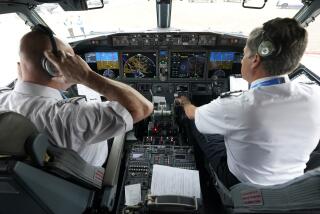Pilots Draw a Line in the Sky
- Share via
The pilot disruption that has prompted American Airlines to cancel hundreds of flights could be a precursor to even worse conflicts ahead if more industry mergers are in the offing.
American’s parent, AMR Corp., recently acquired the regional carrier Reno Air for $124 million. Yet a deal as small and seemingly as simple as that one triggered a contract dispute with American’s 9,200 unionized pilots that, through Tuesday, had inconvenienced tens of thousands of American’s customers.
The job action is the latest evidence to support a long-held tenet of the airline business: It’s not easy to merge two airlines and keep labor peace at the same time.
Speculation is high that much bigger airline mergers lie ahead, at the same time airline unions are pressing harder than ever to achieve gains for their members that repay them for huge wage concessions made in the early 1990s. If any merger threatens to dilute those gains, more disputes could erupt.
Indeed, American’s pilots and their union, the Allied Pilots Assn., “are staking out their ground and trying to set a precedent” in the Reno Air dispute, said Terry Moulton, a partner at Airline Capital Associates, a consulting firm in New York.
The pilots “figure there could be something bigger in the wings” in terms of mergers, “and they’re going to make their point now,” he said.
American Airlines has a history of contentious labor disputes. Two years ago, a contract impasse with its pilots led to a brief strike that ended only after President Clinton intervened.
But throughout the industry, labor relations have been strained in recent years as unions sought a payback for their members’ concessions, which helped the airline industry survive enormous losses in the early 1990s and then enjoy record profits in recent years.
Although there have been a number of agreements--Continental Airlines and its 4,000 pilots, for instance, signed a new contract last summer--there have also been several clashes.
Pilots at Northwest Airlines grounded that carrier for 15 days last year before reaching a new contract. Trans World Airlines accused its flight attendants of waging a “sickout” two months ago that forced TWA to cancel about 200 flights. Mediators this week declared an impasse in contract talks between America West Airlines and its flight attendants, which sets the stage for a possible strike in March.
Those two airlines, in fact, are widely rumored to be the next merger targets, and it’s been confirmed that America West has been approached by Delta Air Lines and United Airlines’ parent, UAL Corp.
But the people factor has long been a key hurdle to airline mergers because such deals require the complex melding of pilots, flight attendants, mechanics, reservation clerks and other workers who often operate under different union contracts that cover their wages, benefits and work rules.
And because the airline business is so dependent on good service, executives often do not pursue mergers because they don’t want disgruntled employees if those contracts cannot be integrated smoothly. Such was the case in 1995, when UAL decided not to bid for US Airways after talking it over with United’s workers. UAL is 55% owned by its employees.
On Tuesday, American and the pilots union returned to the negotiating table in a bid to resolve the dispute, which mainly centers on the union’s complaint that Reno Air’s pilots are not immediately getting raises to put them on equal footing with American’s pilots, who are seeking to protect their existing wage scales.
American said the talks Tuesday were “helpful,” and that it would meet with the APA again today. AMR’s stock has taken a hit since the disruptions began. On Tuesday, its shares fell $1.50, nearly 3%, to close at $55.50 on the New York Stock Exchange.
But the resumption of talks came only after American had canceled more than 1,300 flights since late Friday, when union leaders began encouraging the pilots to take sick leave and refuse to volunteer for extra flying. American, the nation’s second-largest airline, has about 2,200 flights a day.
The disruptions hit hardest in the New York and Miami areas. American said it has been able to re-book most passengers on other carriers, but there is concern that if the dispute carries into the busy Presidents Day holiday this weekend, American could see bigger problems.
Some observers expect more mergers despite the American-Reno Air problems.
“I don’t think it will inhibit future airline merger activity,” said Fred Klein, president of GRA Aviation Specialists Inc., a consulting firm in Herndon, Va.
Even so, the American tiff is a reminder to airline executives that “communicating to all their players in a frank way, prior to pulling the trigger” in a merger “would cause a lot of people to be more open-minded about it,” said Brad Bartholomew, who publishes an aviation-labor newsletter called the Newfoundland Report in Fort Worth.
Times wire services were used in compiling this report.
(BEGIN TEXT OF INFOBOX / INFOGRAPHIC)
TAKING OFF Airlines’ personnel costs have risen at a faster pace than the industry’s sales in recent years, as labor unions demand repayment for their workers’ concessions in the early 1990s.
SALES (In billions)
1999: $93.8 billion* &
PERSONNEL COSTS (In billions)
1999: $30.8 billion*
* Estimates
Source: Salomon Smith Barney Inc.
More to Read
Inside the business of entertainment
The Wide Shot brings you news, analysis and insights on everything from streaming wars to production — and what it all means for the future.
You may occasionally receive promotional content from the Los Angeles Times.











